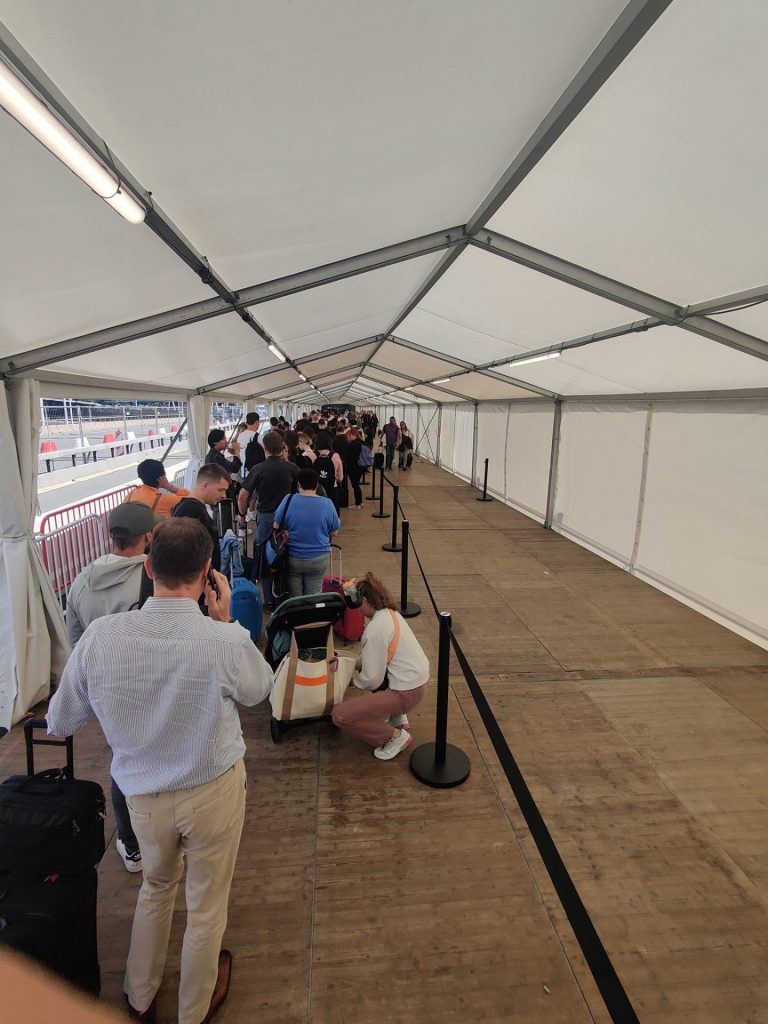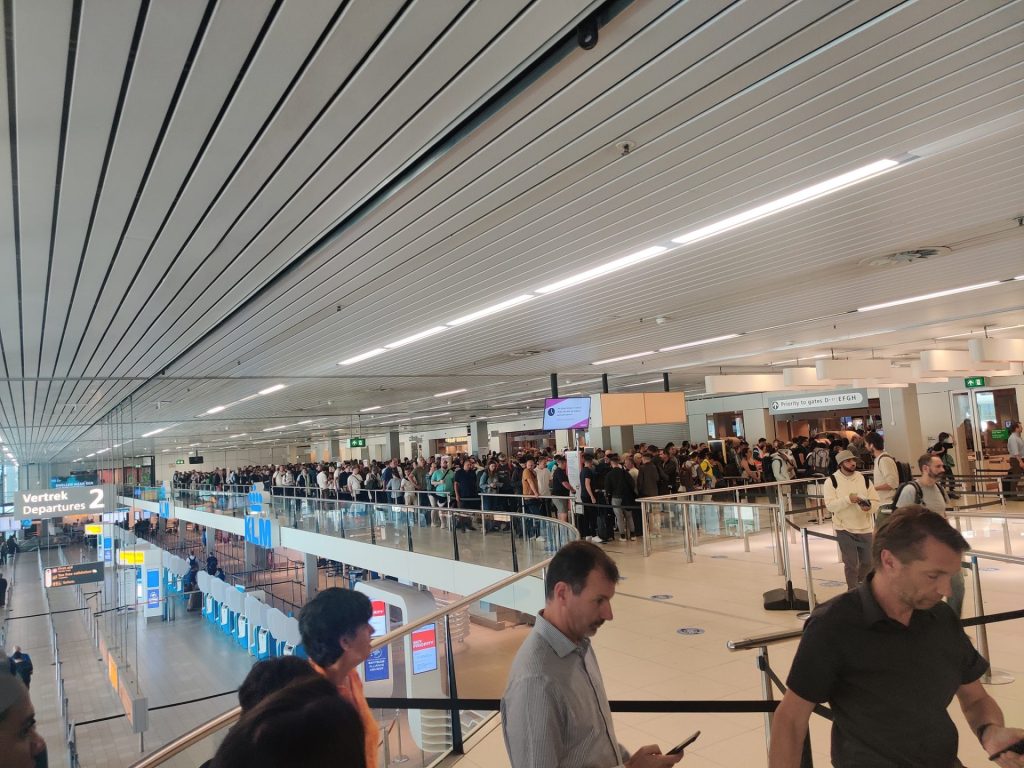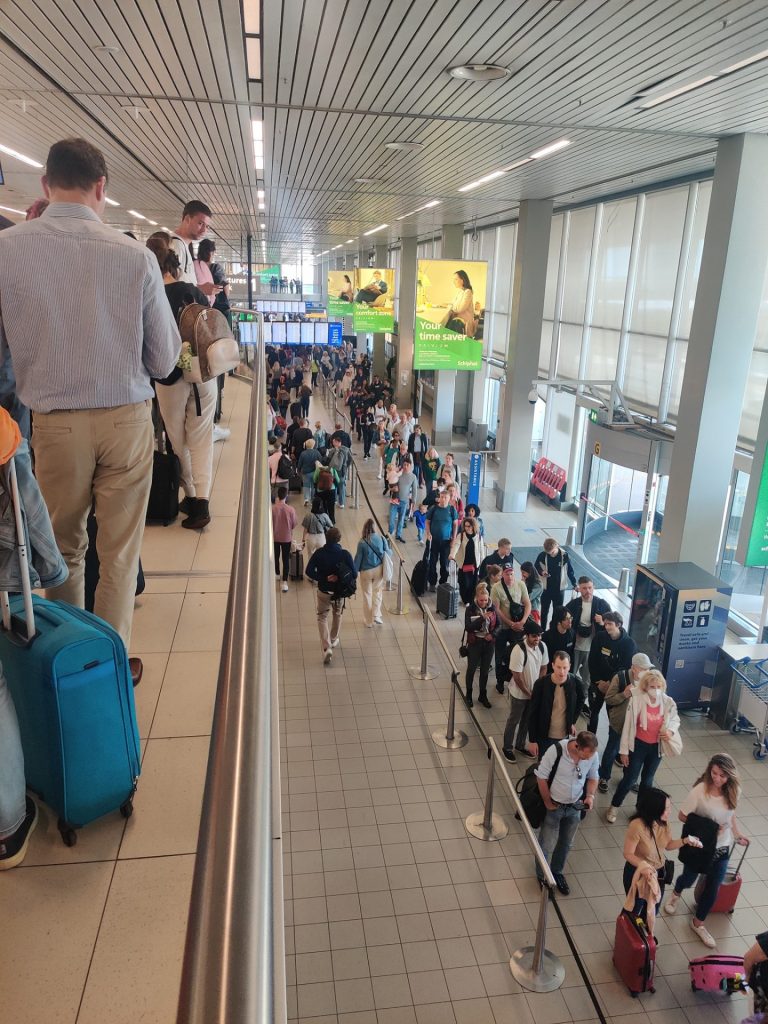The Airport Queue: Thoughts About the Labor Market

I have just dropped off my bag and I am trying to find my way to the gate on Schiphol Airport. The signposts are contradicting and confusing which, to my experience, is a typical Dutch style. There shouldn’t be a problem, I don’t even need to go through passport control. I pass through a queue which is continuing up the stairs. This couldn’t be my way, I think, but I decide to ask the staff and they confirm that I need to be on this queue, too.
I’m now trying to find the queue’s end. I’m walking and walking, but it never ends. I reach a door going to airport’s yard. There is a tent set up as a continuance of the building and it is hundreds of meters long. I realize that I need to go to its end to even join the queue. While walking, I count and confirm in my head that I have arrived the traditionally suggested two hours before the flight, but now I regret my decision to kill my last two hours in Amsterdam on a sightseeing boat. Did I just miss my plane over sightseeing?
On the end of the queue a staff member is screaming:
-Before or after two o’clock?
-At two sharp, I say.
-Go to the queue, you should make it, he reassures me.
Now on the queue, I meet the confused faces of those arriving after me. A few minutes ago, I was as shocked as them, but now I am just bored, dragging my feet slowly forwards. There is a sense of helplessness on this queue – no one can get around it. It is curving through the airport as a mythical snake – from the yard to the interior, the stairs, and the multifold labyrinth of security check. I now think, I have never seen a queue like this. I know though, I only need to concentrate on getting through, while my activity bracelet is documenting the distance for me. I just take a few photos as evidence of this craziness.

Picture 1. The measurement of my activity bracelet on the queue of Schiphol – one hour of walking and a distance of 2,68km.
By the time I reach the security check I’ve received feedback from Finland that this situation has been on the news and is due to shortage of staff. I don’t see any shortage of staff, everything is working on its full capacity and looks busy, unlike Helsinki-Vantaa Airport two days earlier, which seemed half-empty, although there were warnings of possible congestion due to the post-pandemic summer holiday season starting (Toivonen, Karhu & Keränen 2022).
Picture 2. View of Schiphol’s queue from the tent, upstairs and downstairs
A global phenomenon
I have been travelling for a month, both for business and leisure, so I have been detached from the news about the situation on several airports around the world (e.g., Kröger 2022). On my first day back at the office, I learn on a webinar that Schiphol has become a symbol of the shortage of staff worldwide. It is evidence of a demographic trend we’ve been warned about many times through the years, but somehow the covid-19 pandemic catalyzed this process too (e.g., Dolan 2022), and the humanity is once again surprised and unprepared. In this case, the airports around the world are not able to react to the new wave of tourists after the harsh layoffs of staff going on for two years.
On a webinar of Nordic Business Forum (Psychological Safety with Amy Edmonson, 2022), Eivind Bøe, a CEO of Randstad Norway, talks about how to recruit and retain talents in an uncertain market. It is a battle for talents, he says, in a world where there aren’t enough people. According to the 2022 Randstad Employer Brand Research (Randstad Employer Brand Research 2022, 2022), the unemployment rate in the EU is at its lowest for the past 15 years, and also in the USA and Norway there are about double vacancies compared to the number of unemployed. Bøe points out that still 8 out of 10 companies have the plan to grow by recruitment. But how?
The Norwegian HR company suggests the key is a strong employer brand, which means that the employer must be attractive, recognizable, and likable (Psychological Safety with Amy Edmonson, 2022). Bøe pulls up a figure from the report, presenting five main ways to attract and keep employees:
- by attractive salaries and benefits,
- by work-life balance,
- by job security,
- by pleasant work atmosphere,
- by career progression.

Picture 3. A slide from Bøe’s presentation on the seminar: the five global drivers of potential employees.
According to the report, there are differences in the shares of importance these drivers hold around the world, but pretty much every employee is motivated by a mix of them (Randstad Employer Brand Research 2022, 2022).
Finland’s perspective
Both fortunately and unfortunately, Finland is usually situated in the periphery of events, mainly for geographical and demographic reasons. There simply aren’t enough people in Finland to enforce any trend on such a drastic scale. So far up in the North we usually get only a mild impact of changes.
This time around, however, it is going to be different. The lack of labor will not be saved by the small amount of people living in the country, but naturally it will be catalyzed by it. There is the same sense of helplessness in the air as the one experienced on the queue of Schiphol. By analyzing the news of YLE, the Finnish Broadcasting Company, for the first two weeks of June 2022 only, there have been news on shortage of staff in the restaurant and catering sector (Collin et al. 2022; Valtanen 2022), the healthcare and education (Karhu 2022; Tiihonen 2022), the fields of trade (Martikainen 2022) and transport (Thynell 2022).
To my personal experience, Finnish labor market is not as dynamic as the ones in other Nordic countries and the rest of Europe – a claim that a former colleague, Jenny-Liisa Salila, now specialized in HR, confirms:
-Working with several international companies, I can say that, in general, Finnish labor market doesn’t match the dynamics of other Nordic and many Central European countries. In Finland, the processes are too often slow, rigid and monotonous from the applicant’s point of view. Applicants often have to go through week-long interview processes, personality tests, and comprehensive bureaucratic processes even for simple tasks.
Salila points out that fair and open, simple and friendly recruitment is also an important incentive for potential employees.
Are we going to make it to our next flight? It is up to policy makers and employers to react fast to the change and listen to HR professionals to make the labor market more attractive to the current and potential employees and to create the new normal – a more stable one.
Author: Rositsa Röntynen (MSc Sport and Health Sciences) works as an expert and project manager in the field of tourism, with the focus of responsible development. She’s also an expert in marketing. In her free time she loves to travel, dapple in nature photography, and do gigs as a pop-performer.
References:
Collin, P., Kainulainen, J., Loukkola, P., Rautoma, H., Uusi-Kraapo, K, Manninen, C. 2022. Ravintola-alan työvoimapula vaivaa kaikkialla Suomessa – sulkemisilta on pääosin vältytty. A news article on YLE’s website (in Finnish). Published 15.6.2022. Retrieved 17.6.2022 from https://yle.fi/uutiset/3-12493028.
Dolan, M. 2022. Column: Global worker shortages may only worsen post-COVID. Article on Reuters’ website. Published 19.1.2022. Retrieved 17.6.2022 from https://www.reuters.com/markets/europe/global-worker-shortages-may-only-worsen-post-covid-mike-dolan-2022-01-19/.
Karhu, O. 2022. Espoon kaupunki houkuttelee lisää työntekijöitä varhaiskasvatukseen maksamalla kannustinpalkkiota 160 euroa kuukaudessa. A news article on YLE’s website (in Finnish). Published 14.6.2022. Retrieved 17.6.2022 from https://yle.fi/uutiset/3-12493106.
Kröger, T. 2022. Matkustajien kannattaa varautua jonoihin Helsinki-Vantaalla – useilla kansainvälisillä lentoasemilla ruuhkat piinaavat vieläkin pahemmin. A news article on YLE’s website (in Finnish). Published 3.6.2022. Retrieved 17.6.2022 from https://yle.fi/uutiset/3-12474323.
Martikainen, A. 2022. Ravintolat eivät ole yksin työvoimapulansa kanssa – kaupan alan yrittäjä: Haastavaa löytää työntekijöitä, jotka ovat valmiita sitoutumaan. A news article on YLE’s website (in Finnish). Published 14.6.2022. Retrieved 17.6.2022 from https://yle.fi/uutiset/3-12490564.
Psychological Safety with Amy Edmonson, 2022. A video on Nordic Business Forum’s YouTube channel. Published 13.6.2022. Retrieved 17.6.2022 from https://www.youtube.com/watch?v=sKo9KvpA7eE.
Randstad Employer Brand Research 2022, 2022. A report on Randstad’s webpage. Retrieved 17.6.2022 from https://workforceinsights.randstad.com/randstad-employer-brand-research-global-report-2022.
Thynell, T. 2022. Helsingin ratikat siirtyivät harvempaan vuoroväliin – syynä pitkittynyt kuljettajapula. A news article on YLE’s website (in Finnish). Published 13.6.2022. Retrieved 17.6.2022 from https://yle.fi/uutiset/3-12490176.
Tiihonen, J. 2022. Työvoimapula voi heikentää Rovaniemen terveysasemien puhelinpalvelua – takaisinsoitto voidaan joutua sulkemaan kesällä. A news article on YLE’s website (in Finnish). Published 15.6.2022. Retrieved 17.6.2022 from https://yle.fi/uutiset/3-12494223.
Toivonen, H., Karhu, O. & Keränen, T. 2022. Helsinki-Vantaan lentoasemalla historiansa suurimmat ruuhkat – ”Näyttää siltä, että koko maailma on nyt liikkeellä”. A news article on YLE’s website (in Finnish). Published 10.6.2022. Retrieved 17.6.2022 from https://yle.fi/uutiset/3-12486409.
Valtanen, T. 2022. Kauppajätti S-ryhmä sulkee yllättäen kymmenkunta ravintolaa kesäksi pääkaupunkiseudulla – taustalla ankara työvoimapula. A news article on YLE’s website (in Finnish). Published 13.6.2022. Retrieved 17.6.2022 from https://yle.fi/uutiset/3-12479758.



